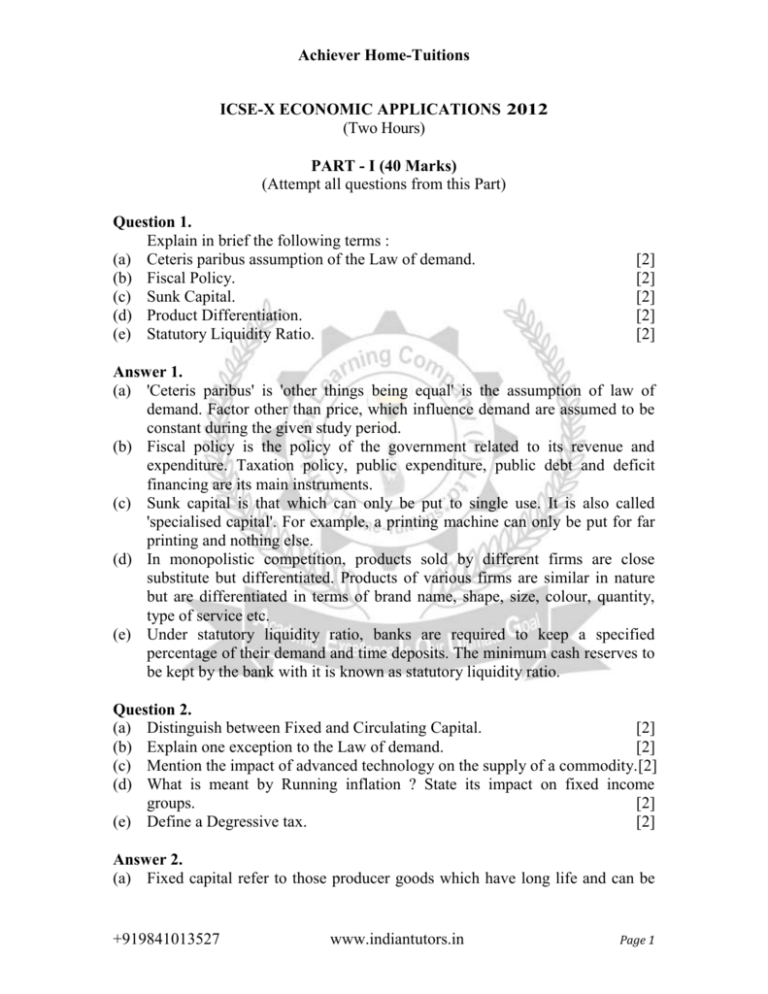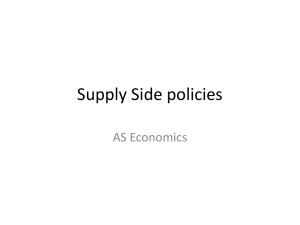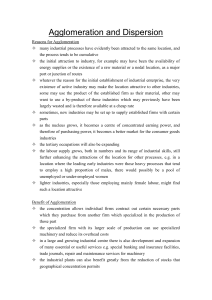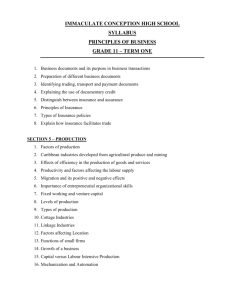2012
advertisement

Achiever Home-Tuitions ICSE-X ECONOMIC APPLICATIONS 2012 (Two Hours) PART - I (40 Marks) (Attempt all questions from this Part) Question 1. Explain in brief the following terms : (a) Ceteris paribus assumption of the Law of demand. (b) Fiscal Policy. (c) Sunk Capital. (d) Product Differentiation. (e) Statutory Liquidity Ratio. [2] [2] [2] [2] [2] Answer 1. (a) 'Ceteris paribus' is 'other things being equal' is the assumption of law of demand. Factor other than price, which influence demand are assumed to be constant during the given study period. (b) Fiscal policy is the policy of the government related to its revenue and expenditure. Taxation policy, public expenditure, public debt and deficit financing are its main instruments. (c) Sunk capital is that which can only be put to single use. It is also called 'specialised capital'. For example, a printing machine can only be put for far printing and nothing else. (d) In monopolistic competition, products sold by different firms are close substitute but differentiated. Products of various firms are similar in nature but are differentiated in terms of brand name, shape, size, colour, quantity, type of service etc. (e) Under statutory liquidity ratio, banks are required to keep a specified percentage of their demand and time deposits. The minimum cash reserves to be kept by the bank with it is known as statutory liquidity ratio. Question 2. (a) Distinguish between Fixed and Circulating Capital. [2] (b) Explain one exception to the Law of demand. [2] (c) Mention the impact of advanced technology on the supply of a commodity.[2] (d) What is meant by Running inflation ? State its impact on fixed income groups. [2] (e) Define a Degressive tax. [2] Answer 2. (a) Fixed capital refer to those producer goods which have long life and can be +919841013527 www.indiantutors.in Page 1 Achiever Home-Tuitions (b) (c) (d) (e) used again and again for further production of goods, for example, machinery, plants, factory buildings, office furniture etc. Circulating capital refer to those goods which can be used in production only once such as raw materials, fuel etc. They are directly absorbed into the finished products. For example, wheat (in flour mills) printing ink (in printing press). In the case of giffen goods, the law of demand does not apply because they are those inferior goods on which the consumer spends a large part of his income and the demand for which falls with a fall in price and rises with a rise in price. Use of improved and advanced technology increases the productivity of resources and hence overall cost of production. Hence, the supply also increases. When the price level rises at a faster rate and is generally around 10 per cent per annum, it is called running inflation. Running inflation is a warning signal indicating the need for controlling it. Fixed income groups such as pensioners lose during inflation. Under degressive tax, the rate of tax increases upto a certain limit but after that a uniform rate is charged. This sort of degressions is found in practice in case of income tax. Question 3. (a) Capital is the result of past labour. Briefly explain. [2] (b) Define Monopsony. [2] (c) Producers in a Monopoly market are price makers. Briefly explain. [2] (d) What is bank rate ? How is it altered to correct a depression in an economy ?[2] (e) With the help of a formula calculate the elasticity of supply from the following table : Price ft) Quantity supplied (units) 10 200 15 225 Answer 3. (a) Capital is the result of savings which are made by man. Capital is the mixed result of past labour of workers working on natural resources. Thus, when human labour is applied to natural resources, then capital items are generated. (b) Monopsony refers to a market where there is a single buyer of a commodity or service. But there are many sellers. For example, Government of India for buying fighter aircraft's. (c) Producers in a monopoly market being the sole producer has full control over the supply of the product. This enables him to exercise full control over the market price. He can influence the market price of the product by varying its +919841013527 www.indiantutors.in Page 2 Achiever Home-Tuitions supply. So, producers in monopoly market are price makers. (d) Bank rate is the rate at which the central bank gives loans to the commercial banks or rediscounts the approved bills of exchange and the securities held by the commercial banks. To correct a depression in an economy, there is a need to increase the quantity of credit and hence purchasing power of people, for this the RBI will reduce the bank rate. es (e) Q P 25 10 25 P Q 5 200 (es) Elasticity of supply comes to 0.25. Question 4. Citing reasons state the advantage of (a) a progressive tax over proportional tax. (b) monopolistic competition over monopoly. (c) private sector over public sector. (d) a direct tax over an indirect tax. (e) a credit card over currency notes. [2] [2] [2] [2] [2] Answer 4. (a) A progressive tax leads to just and equitable distribution of tax burden as it imposes higher tax burden on the rich while proportional tax does not involve a just and equitable distribution of tax burden because rich and poor are taxed at the same rate. (b) Firms under monopolistic competition are free to enter or leave the industry at any time. Now firms may start producing close substitutes of the product. Likewise, in the event of losses, the old firms may quit the industry, but under monopoly now firms can not enter the industry. There are strong barriers that prevent new firms to enter the industry. (c) The government servants in public sector do not have the same incentive to do their best as a man in private sector. In the government service, promotion is awarded simply by seniority and not by merit but in private sector workers perform their best to get good incentive. (d) A direct tax is an equitable tax as it is levied according to the tax paying capacity of the people while indirect taxes do not discriminate between the poor and the rich with regard to consumption of any particular commodity. (e) A credit card represents plastic money and in the event of theft the credit card can not be used by the thief, it can only be used by the owner who has to sign in the establishment after swiping the card. On the other hand, carrying currency notes can be risky because they can be used by whoever steal them. PART - II (60 Marks) Attempt any four questions from this Part +919841013527 www.indiantutors.in Page 3 Achiever Home-Tuitions Question 5. (a) Explain with the help of an example the Horizontal and the Vertical division of labour. Mention any three merits of division of labour. [7] (b) Define Composite demand. Clearly explain any three determinants of demand in a market. [8] Answer 5. (a) In Horizontal division of labour, the production process is so organised that the different parts of the process can run simultaneously. For example, in case of automobiles, different parts are manufactured simultaneously and then assembled together at the end. In vertical division of labour, the production process is so organized that there are successive stages in the production of a commodity. For example, in cotton textile industries, raw cotton is first transformed into yarn by spinning. Only then can the yarn be woven into cloth. Thus, weaving depends upon spinning and dying depends upon weaving. Merits of division of labour : (i) Right man at the right job : Every worker is assigned a job for which he is best suited. When the job matches worker's capability, aptitude and taste, he gets job satisfaction and a motivation to give his best. (ii) Increase in labour efficiency : Division of labour permits a worker to repeat the same task again and again. This gives him specialization, proficiency and perfection in that task. This makes him expert in the job and improves his efficiency in terms of quantity, quality and time. (iii) Saving of time : As the worker is required to carry out only one type of job, he is not required to move frequently from one job to another. Also he need not to change the tool or machine now and then. This saves time and increases output. (b) Demand for a commodity which can be put to several uses, is called composite demand, for example - milk, electricity, coal etc. Determinants of demand : (i) Price of the commodity : There is an inverse relationship between demand for a commodity and its price. When the price rises, demand falls and vice-versa. (ii) Price of related goods : In case of complimentary goods when the price of a good rises, the quantity demanded for its compliment falls and vice versa. In case of substitute goods, when the price of one good rises, the quantity demanded of its substitute also rises and vice versa. (iii) Consumer's tastes and preferences : They depend upon a number of factors such as social customs, habits, fashion, age, family background, +919841013527 www.indiantutors.in Page 4 Achiever Home-Tuitions general life style, influence of advertisements etc. Change in any of these factors leads to change in consumer's taste and preference and hence, the demand for the commodity. Question 6. (a) What is meant by privatization ? Explain in brief three arguments against privatization of public sector units in India. [7] (b) Explain four characteristics of a perfectly competitive market. [8] Answer 6. (a) Privatization is the process which leads to transfer of ownership of public sector enterprises from the government to the private sector and the policy of granting autonomy to the public sector enterprises. Thus, any process that reduces the participation of the state or public sector and greater role for private sector in economic activities of a country is called privatization. Arguments against privatization of public sector units in India : (i) Social welfare neglected : Public sector enterprises are set up to achieve social welfare while private sector enterprises operate mainly with the objective of profit-maximization. Private operators would not like to provide goods at the subsidized prices to the poor consumers to promote social welfare. (ii) Possibility of unemployment : One of the fears of labour is that privatization will lead to unemployment. The experience of privatization in many countries is testimony 10 this fact. (iii) Cumbersome process : Privatization needs strategic planning efforts as well as appropriate administrative apparatus to carry it out. However, in developing economy like India, this is not feasible due to cumbersome bureaucratic system. (b) Characteristics of a perfectly competitive market: (i) Large number of buyers and sellers : Under perfect competition, number of buyers is very large and thus no single buyers can influence the market price of the good. Similarly, there are large number of sellers so that no single seller or firm can influence the market price. Therefore, the price is determined by the total supply of the industry and the total demand in the market. All buyers and sellers are 'price-takers'. (ii) Homogeneous products : All the firms sell goods which are completely identical with regard to quality, shape, colour, size, design, packing, servicing and all other attributes associated with the product. Thus, buyers do not have preference for a particular seller. Thus, no firm has any basis for charging higher price for its product. This ensures a uniform price throughout the market. (iii) Free entry and exit of firms : New firms can enter the industry without +919841013527 www.indiantutors.in Page 5 Achiever Home-Tuitions any time and cost barriers. Similarly, quitting the industry is also easy and quick. Thus, if existing firms in the industry make super normal profits, new firms can enter the industry so that extra profits are removed. If existing industries make losses they can move out of the industry so that losses are removed. Thus, all firms in perfect competition will make only normal profits in the long run. (iv) Absence of selling cost: Selling cost are incurred by the firms to increase their sales such is expenditure on advertisement, publicity etc. Under perfect competition, goods are completely identical and sold at uniform price. Hence, firms need not incur any selling cost. Question 7. (a) Explain the terms Impact, Shifting and Incidence of a tax. Explain in brief two merits of direct tax. [7] (b) Define price elasticity of supply. With the help of suitable diagrams explain the following degrees of elasticity. (i) Perfectly elastic supply. (ii) Perfectly inelastic supply. [8] Answer 7. (a) When the government of any country imposes a tax, then the person or the institution which bears the tax burden at the first instance is known as the impact of the tax. On the other hand, if the tax payer can shift the burden of tax, then the final resting point of the tax burden is called the incidence of tax. For example - in case of sales tax, the impact point is the seller while the point of incidence is buyer. Two merits of direct tax : (i) Equitable : A direct tax is an equitable tax as it is levied according to the tax paying capacity of the people. Under progressive taxation system, tax rate increases as the income increases (ii) Economical : Direct taxes are economical in the sense that cost of collecting them is tow. They are usually collected 'at the source'. For example, the income tax is deducted from an officer's pay every month. (b) Price elasticity of supply is a measure of the degree of responsiveness of quantity supplied to changes in the product's own price. +919841013527 www.indiantutors.in Page 6 Achiever Home-Tuitions (i) Perfectly elastic supply : Perfectly elastic supply represents a case in which the quantity supplied responds by an infinite amount to a very small change in price. In fig., we have drawn an infinitely elastic supply curve S\, which runs parallel to Xaxis, i.e., it is a horizontal straight line. It has infinite elasticity at price OP1 showing that sellers are prepared to sell an infinitely large quantity at the price OP, and nothing would be supplied at all at a slightly lower price. This is an extreme case of supply curve. (ii) Perfectly inelastic supply : If there is no change in quantity supplied with changes in the price of the product then the supply of that commodity becomes completely inelastic (i.e., es = 0). For example, when price per kg. increases from ` 2 to ` 3, then the quantity supplied may remain unchanged at 10 units. The supply curve will be a vertical line. Question 8. (a) Define Production. Explain three factors which determine land productivity.[7] (b) Explain an important characteristic of each of the following factors of production : (i) Land (ii) Labour (iii) Capital (iv) Entrepreneur [8] Answer 8. (a) The art of making goods and services is called production. Production creates economic utility in goods and services. Productivity of land depends upon a large number of factors. These factors are : (i) Natural factors : Land productivity is largely determined by its natural qualities such as fertility, climate, chemical and biological properties of the soil, slope of land etc. (ii) Human factors : Land is a passive factor of production. It cannot produce anything by itself. Efforts of labour generate yield from land. Thus, productivity of land also depends upon the knowledge and training of labour. A wise farmer can grow more produce on the same land than an untrained farmer. (iii) Availability of capital : Land productivity can be increased with the help +919841013527 www.indiantutors.in Page 7 Achiever Home-Tuitions of machines, chemical manures, improved seeds, implement and scientific methods. Intensive cultivation gives a higher productivity on a small piece of land (b) (i) Land : Free gift of nature : Land is a free gift of nature given to man free of cost. Man has to spend nothing to obtain it. He has to make no efforts to get it. (ii) Labour : Labour is perishable : Labour is perishable. Labour cannot be stored. The labour has to sell his labour immediately irrespective of the prices paid to him. (iii) Capital: Capital is a passive factor of production : Like land, capital is also a passive factor of production. It cannot produce anything by itself. It becomes effective only when it is used by labour. (iv) Entrepreneur : All other factors are employed by the entrepreneur in the production process. But entrepreneur is not a hired factor of production. Question 9. (a) Name the bank which has sole authority to issue currency in India. Mention three ways by which it differs from a commercial bank. [7] (b) Define Money. Explain how money performs the following functions : (i) As a measure of value. (ii) As a standard of deferred payment. (iii) As a store of value. Answer 9. (a) Reserve Bank of India has sole authority to issue currency in India. Difference between Central Bank and Commercial Bank : Basis Central Bank Commercial Bank (i) Status It regulates the entire banking It just operates under system of the country. the guidelines of the central bank (ii) Aim To promote social welfare. To earn profit. (iii) Currency issue It has monopoly right of It does not have such issuing currency. rights. (b) Anything that is generally acceptable as a means of exchange and at the same time, acts as a measure and store of value is called money. Functions of money: (i) As a measure of value : Money acts as a common measure of value. It serves as a unit of measurement in terms of which the values of all goods and services are measured and expressed. +919841013527 www.indiantutors.in Page 8 Achiever Home-Tuitions (ii) As a standard of deferred payment: Money acts as a standard of deferred payment. It means payment to be made in future can be expressed in term of money. Money is accepted as a standard of deferred payment because it has a general acceptability. (iii) As a store of value : Money acts as a store of value. People can store their wealth in the form of money. Though there are some other things which can be stored like money such as gold, shares bond, debentures etc. But money is considered as a better storage of value because it is a perfectly liquid asset. Question 10. (a) What is a Public sector undertaking ? Explain three problems faced by public sector undertakings in India. [7] (b) Read the excerpt given below and answer the questions that follow : The Hindu, 11th July 2011. "We need to remember that we should work towards bringing nearly 400 million citizens to the formal fold of the banking sector," said RBI Deputy Governor, K.C. Chakraborty. In rural areas, where accessibility is a problem, banks are using the Micro finance network business correspondents and facilitators to bring more people under the ambit of banking services. (i) Why is it necessary to bring more people under the formal fold of the banking sector ? Give one reason [1] (ii) Mention one way by which people would benefit from banking services.[1] (iii) Which stage of capital formation is the above extract referring to ? Explain the stage in brief. [2] (iv) Explain two ways in which banks accept deposits. [2] (v) What is meant by cash credit ? [2] Answer 10. (a) Public sector undertakings refer to those enterprises which are owned, managed and controlled by the government. Problems faced by public sector undertakings : (i) Lack of incentive : The government servant do not have the same incentive to do their best as a man in private enterprise has. In government service, promotion is awarded simply by seniority and not by merit. They are least concerned with the profit of the enterprises. (ii) Wasteful expenditure : There is a great deal of waste in the expenditure. The government funds and property are used carelessly by the government officials and other servants. It increases the costs of production in these enterprises. (iii) Corruption : Corruption, bribery and dishonesty are very common +919841013527 www.indiantutors.in Page 9 Achiever Home-Tuitions (b) (i) (ii) (iii) (iv) (v) things in public enterprises. By depositing disposable income of citizens in banks, government gets more leeway in its disposable income for its welfare activities. By depositing disposable income in banks, people will benefit in turn of interest on deposits which the money would not have earned lying at home. The first stage of capital formation is this extract talking about. Acceptance of deposit : This is the first stage of capital formation. The money accepted by commercial banks is in turn used by the bank to supply finance to the entrepreneurs and businessmen with finance in the form of loans for development work. Two ways in which banks accept deposits : (1) Savings deposit : These are those deposits on the withdrawal of which bank places certain restriction. Cheque facility is provided to the depositors. Savings deposit accounts are generally held by households who have idle or surplus money for short period. A low rate of interest is paid on them. (2) Fixed deposits (or time deposits) : These are those deposits which can be withdrawn only after the expire of a certain fixed period. Money deposited in fixed deposit account for a fixed period of time, say one or two or three years, is called fixed deposit. These deposits carry the highest rate of interest. Cash Credit: Under this, the borrower is allowed to withdraw unto a certain amount on a given security which comprises mainly stocks of goods and bills receivable from others. But interest is charged on the amount actually withdrawn. +919841013527 www.indiantutors.in Page 10








